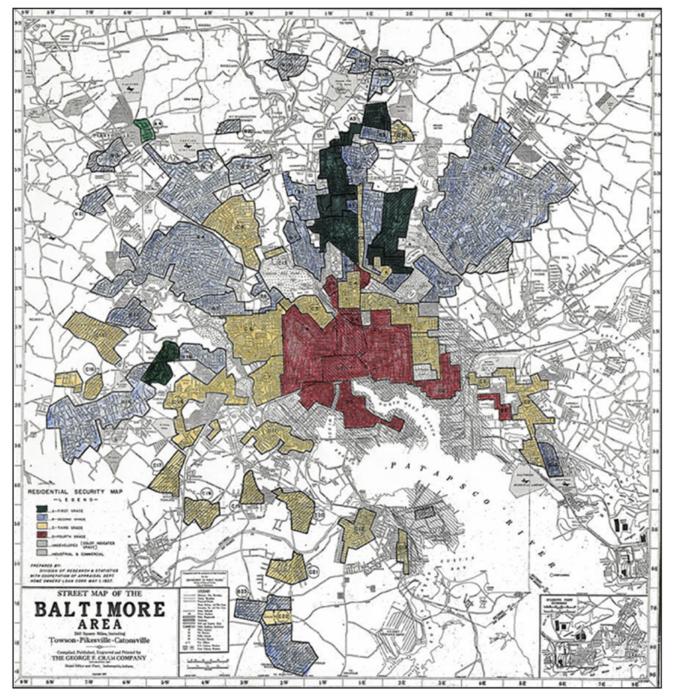An ecological theory may help to explain why segregation is so widespread and persistent in US cities, according to a paper published today in Buildings and Cities. The new way of framing segregation’s endurance may provide a useful tool to study and address systemic racism, and could ultimately reveal novel ways of breaking the cycle.

Credit: Used under a Creative Commons Share Alike license
An ecological theory may help to explain why segregation is so widespread and persistent in US cities, according to a paper published today in Buildings and Cities. The new way of framing segregation’s endurance may provide a useful tool to study and address systemic racism, and could ultimately reveal novel ways of breaking the cycle.
As an urban ecologist at Cary Institute of Ecosystem Studies, Steward Pickett is always on the lookout for spatial differences, or patchiness, in the environment. He then studies those patterns and unpacks their drivers. Working in Baltimore, Pickett and his colleagues couldn’t help noticing the patchy distribution of Black and white populations across the city. But formal policies of segregation ended decades ago.
“So why does Baltimore stay segregated?” he wondered. “And what are the ecological implications of that? This knowledge is critical to supporting anti-racist progress toward environmental justice for all people living in cities.”
Segregation has well documented social and economic consequences. Its legacy can also be felt in the way that environmental resources and risks are unevenly distributed within cities. For example, communities of color are more likely to be exposed to flooding, air pollution, toxic metals, and mosquito-borne diseases, and are less likely to have access to amenities such as green spaces, cooling street trees, and adequate waste removal.
“In Baltimore, through decades of research, we have documented that compared to white neighborhoods, Black Baltimoreans have less tree canopy coverage, more vulnerability to heat extremes, less stormwater management investment, and increased exposure to disease vectors,” said Pickett.
When the team analyzed the history of Baltimore and the institutional and legal mechanisms that have kept segregation in place, the process started to look familiar. “I thought, this looks like the adaptive resilience cycle in ecology literature, but here the resilient trait is white control of the spatial organization of racialized groups in the city,” said Pickett. “It just seemed to be a very powerful way to organize our observations.”
The ‘adaptive cycle of resilience’ emphasizes the ability of a system to adjust to shocks or disturbances and retain its fundamental structure. The theory divides resilience — or in this case, segregation’s tenacity — into four phases: disturbance, reorganization, growth, and conservation of resources.
The cycle starts with a baseline condition. Then, a “disturbance” shakes up that condition, releasing resources or freeing up new ways of thinking (“reorganization”). What follows is a time when the system takes advantage of those opportunities (“growth”) before settling down into a state that persists for a while (“conservation”).
Drawing on historical examples, the paper shows how this cycle has worked to reinforce segregation in Baltimore. In the 1880s, Baltimore was organized by fine-scale segregation, with African Americans living in smaller homes along narrow alleys, and whites living in larger homes on nicer streets. However, starting in the late 1870s, the Great Migration saw large numbers of African Americans moving from the South to the North or from rural to urban areas (acting as “disturbance” to the established pattern of segregation). Baltimore’s Black population surged and began spreading beyond the alley houses (“reorganization”).
Resisting this diffusion through the city, white elites pushed for an ordinance that, in 1911, forbade Black and white residents from living on the same city block (“growth” or novelty in the control of segregation). This coarser scale of segregation persisted for a few years (“conservation”), until the Supreme Court overturned the ordinance in 1917, starting a whole new turn of the resilience cycle, causing Baltimore’s white power structure to initiate alternativemethods to maintain the segregationist system, such as neighborhood improvement associations and deed covenants.
“Again and again, we see that when segregation meets a crisis point, it will reconstruct itself to keep segregation going,” explained Pickett. “It doesn’t go away — it changes scale, and the mechanisms that enforce it change.”
The paper provides several other examples illustrating the similarities between the adaptive resilience cycle and real-world decisions in planning, zoning, investment, and real estate that have reinforced segregation throughout Baltimore’s history. The authors also point out that segregation’s cycle of resilience could be disrupted by community action, policy adjustment, and planning practice.
Baltimore is far from the only city living with modern-day segregation; segregation and its impacts persist in many cities across the US and all over the globe. Understanding the mechanisms that reinforce segregation could help activists to identify or exploit crisis points within the cycle, the authors note, and invite new tools to create a more socially just world.
Pickett hopes the paper will help to change how people think about segregation and systemic racism. “Segregation is not ‘natural’ — it’s been made and reinforced,” he said. “But it doesn’t have to be this way. What can be made can also be unmade.”
Authors
Steward T. A. Pickett – Cary Institute of Ecosystem Studies
J. Morgan Grove – USDA Forest Service
Christopher G. Boone – Arizona State University
Geoffrey L. Buckley – Ohio University
Citation
Pickett, S. T. A., Grove, J. M., Boone, C. G., & Buckley, G. L. (2023). Resilience of racialized segregation is an ecological factor: Baltimore case study. Buildings and Cities, 4(1), pp. 1–18. DOI: https://doi.org/10.5334/bc.317
Funding
This study was made possible by the Baltimore Ecosystem Study, with funding from the USDA Forest Service and National Science Foundation. Any opinions, findings, and conclusions or recommendations expressed in this material are those of the author(s) and do not necessarily reflect the views of either organization.
xxx
Cary Institute of Ecosystem Studies is an independent nonprofit center for environmental research. Since 1983, our scientists have been investigating the complex interactions that govern the natural world and the impacts of climate change on these systems. Our findings lead to more effective resource management, policy actions, and environmental literacy. Staff are global experts in the ecology of: cities, disease, forests, and freshwater.
Journal
Buildings and Cities
DOI
10.5334/bc.317
Article Title
Resilience of racialized segregation is an ecological factor: Baltimore case study
Article Publication Date
26-Sep-2023




